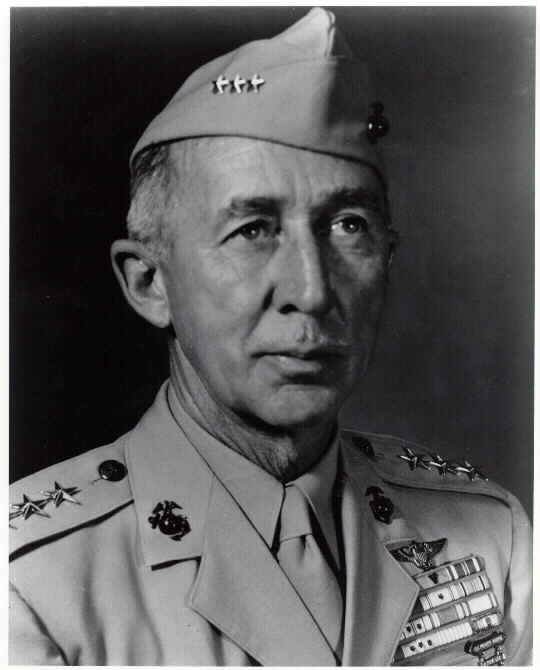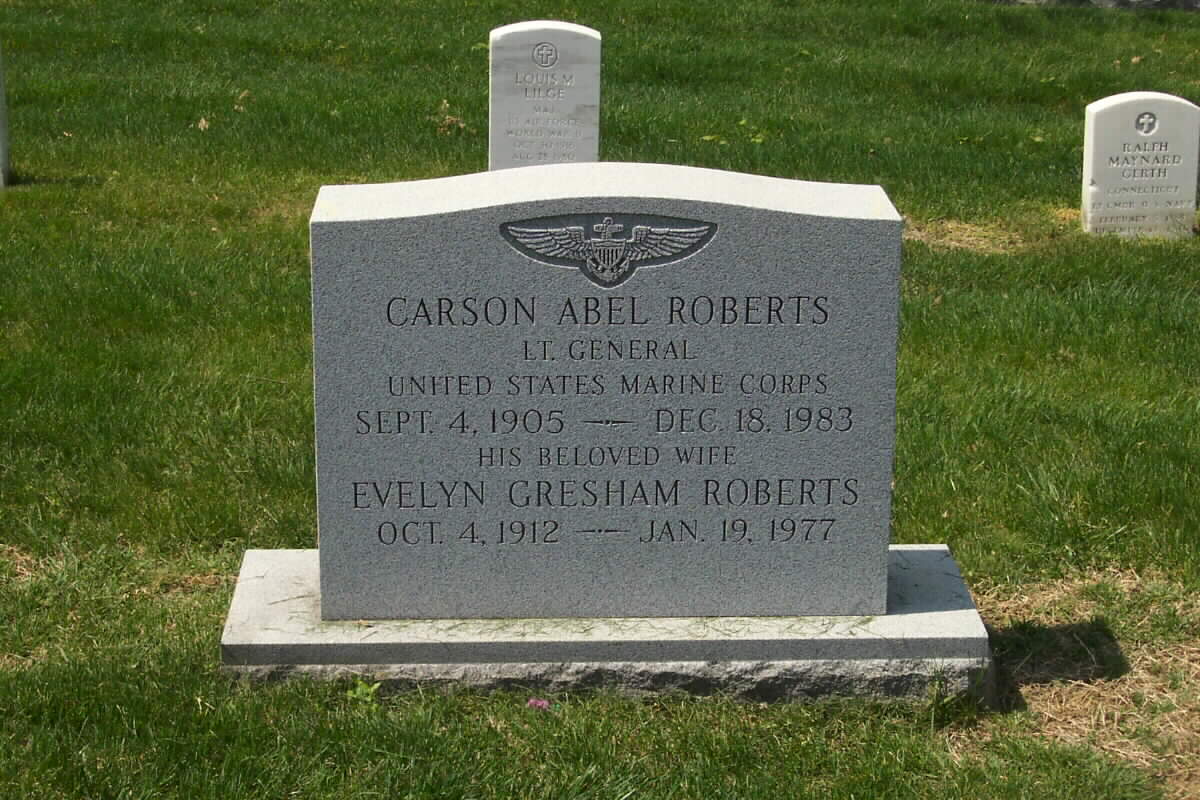Courtesy of the United States Marine Corps
Lieutenant General Carson Abel Roberts, a Marine Aviator, died at his home in Pinehurst, North Carolina on 19 December 1983. Upon his retirement, General Roberts was awarded the Distinguished Service Medal for exceptionally meritorious service as Commanding General, Fleet Marine Force, Pacific, from July 1962 to March 1964. His citation stated in part:
“…Under Lieutenant General Roberts’ dynamic leadership, the combat readiness of Marine Corps units in the Pacific area has substantially increased with attendant reduction in the reaction time required for effective commitment of forces to counter or deter any aggression. His astute foresight, sound judgment and effective planning in preparing, deploying and positioning units were reflected by the ease, efficiency and rapidity with which his forces responded during the several international crises that occurred during his tenure of command. Particularly noteworthy was the rapid response of units to the Cuban situation. Through (his interest and direction, the Fleet Marine Force, Pacific, has refined the aerial refueling capability which enables combat air units, along with ready air transportable ground units to react more rapidly to any contingency…”
General Roberts was born 4 September 1905, at Lancaster, Wisconsin. He graduated from University High School, Madison, Wisconsin, in 1925, and from the University of Wisconsin in 1929 with a Bachelor of Philosophy Degree. He was appointed a Marine second lieutenant 30 July 1929. The following July he completed the Basic School for Marine Corps officers at the Philadelphia Navy Yard.
In March, 1932, after service at the Marine Barracks, Pensacola, Florida, Lieutenant Roberts sailed for Haiti where he served with the 1st Marine Brigade. He returned to this country in January, 1934 to enter flight training at Pensacola and was designated an aviator on 12 November of that year. He was promoted to First Lieutenant in November 1934. In January 1935, he was ordered to Quantico, Virginia, where he saw service with Observation and Fighter Squadrons 7 and 9-M and Aircraft One, Fleet Marine Force. He was promoted to Captain in July 1937.
Leaving Quantico in May 1938, Captain Roberts completed a course at the Army Chemical Warfare School, Edgewood Arsenal, Maryland, the following month. He then served with Scouting Squadron 2 and Marine Aircraft Group 2 at San Diego, California, from July 1938 until June 1940, when he returned to Quantico. There he served successively with Base Air Detachment One, Bombing Squadron 1, and Marine Aircraft Group 11. In addition, he was stationed with Bombing Squadron 1 at Guantanamo Bay, Cuba, from November 1940 to April 1941.
Captain Roberts was serving as Adjutant of Marine Aircraft Group 11 when the United States entered World War II, and with that unit was ordered from Quantico to San Diego a few days after the attack on Pearl Harbor. He was promoted to Major in January 1942. That May, Major Roberts was named Group Operations Officer. He was promoted to lieutenant colonel in August 1942, and the following month was detached from the group.
After instruction at the Army Air Force School of Fighter Command in Orlando, Florida, Lieutenant Colonel Roberts left for the Pacific area. As Operations Officer, 4th Marine Aircraft Wing, he saw duty in Hawaii, Samoa, and the Ellice and Gilbert Islands. He was promoted to Colonel in January 1944.
Colonel Roberts became Assistant Operations Officer on the Staff of the Commander, Shore Based Aircraft, Forward Area, Central Pacific, in April 1944. For meritorious service in this capacity during operations against the Japanese in the Marshall, Caroline, and Mariana Islands, he was awarded his first Bronze Star Medal with Combat “V”. He returned to the United States in November 1944 to serve as Assistant Chief of Staff, Marine Fleet Air, West Coast, San Diego.
In March 1945, Colonel Roberts was assigned to Hawaii, heading the Future Plans Section, Aircraft, Fleet Marine Force, Pacific, until the end of the war. While serving in this capacity, he was awarded a second Bronze Star Medal for meritorious achievement in planning the employment of Marine air units in the Okinawa campaign and the occupation of Japan. He was named Assistant Chief of Staff, G-3 (Operations and Training), 1st Marine Aircraft Wing, in September 1945, and in that assignment his duties took him to the Philippines, Okinawa, and China.
Returning to the United States in November 1945, Colonel Roberts commanded the Marine Corps Air Station at Eagle Mountain Lake, Texas, until April 1946. He then served briefly with the 2d Marine Aircraft Wing at Cherry Point, North Carolina, and entered the Army Command and General Staff College, Fort Leavenworth, Kansas, that August. He completed the course in July 1947 and for the next two years was Chief of the Aviation Section, Marine Corps Schools, Quantico. From July 1949 to April 1951, he was Assistant Chief of Staff, G-3, Marine Air Reserve Training Command, Glenview, Illinois.
Ordered to Korea in May 1951, Colonel Roberts saw action there until March 1952, serving successfully as Deputy Chief of Staff, 1st Marine Aircraft Wing; Commander, Marine Aircraft Group 33; and Chief of Staff, 1st Wing. He was awarded the Legion of Merit with Combat “V” for outstanding service as group commander, and the Distinguished Flying Cross for heroism in that capacity on 10 November 1951 while leading a close air support strike near Sohui-ri. In May 1952, he became Chief of Staff, Aircraft, Fleet Marine Force, Atlantic, at Norfolk, Virginia.
Colonel Roberts was ordered to Quantico in July 1953, serving there consecutively as a member of the Advanced Research Group, Marine Corps Schools, and as Assistant Commander, Marine Corps Air Station. In August 1954, he became Director of the Marine Corps Development Center. He was promoted to Brigadier General in July 1955.
General Roberts was transferred from Quantico in January 1956. Assigned to Washington, D.C., he served as Inspector General of the Marine Corps until October 1956, at which time he joined the staff of the Secretary of Defense as Director of Armed Forces Information and Education. He resumed temporarily his former duties as Inspector General of the Marine Corps in October, 1957. He was promoted to Major General in November 1957.
In December 1957, General Roberts became Deputy Chief of Staff (Plans) at Headquarters Marine Corps. He served in this capacity until March 1959, and the following month assumed duties in Japan as Commanding General, 1st Marine Aircraft Wing. On his return to the United States in December 1959, he served for over a year and half as Commanding General, 3d Marine Aircraft Wing, El Toro. He then remained at El Toro where he served as Commanding General, Aircraft, Fleet Marine Force, Pacific, from June 1961 until June 1962. On 1 July 1962, he was promoted to lieutenant general and assumed command of Fleet Marine Force, Pacific, at Camp H.M. Smith, Hawaii. He served in this capacity until his retirement, 1 March 1964.
A complete list of the general’s medals and decorations includes: the Distinguished Service Medal, the Legion of Merit with Combat “V”, the Distinguished Flying Cross, the Bronze Star Medal with Combat “V”, and Gold Star in lieu of a second award, the Presidential Unit Citation, the American Defense Service Medal with Base clasp, the Asiatic-Pacific Campaign Medal with three bronze stars, the American Campaign Medal, the World War II Victory Medal, the China Service Medal, the National Defense Service Medal, the Korean Service Medal with four bronze stars, the United Nations Service Medal, and the Korean Presidential Unit Citation.
Carson Abel Roberts was born in Lancaster, Wisconsin, in 1905. He received his Bachelor of Philosophy degree from the University of Wisconsin in 1929, and in that same year he was appointed a Second Lieutenant in the United States Marine Corps.
During World War II, Roberts served as Operations officer in the 4th Marine Aircraft Wing.
After the war he entered the Command and General Staff College at Fort Leavenworth, Kansas, graduating in 1947. He next became Chief of Aviation Section of the Marine Corps schools and in 1949 became Assistant Chief of Staff for the Marine Air Reserve Training Command at Glenview, Illinois.
During the Korean Conflict, Roberts served as Deputy Chief of Staff, then was promoted to Chief of Staff of the 1st Marine Aircraft Command.
Roberts was promoted to Lieutenant General and became Commanding General of the Pacific Fleet Marine Force in 1962.
Michael Robert Patterson was born in Arlington and is the son of a former officer of the US Army. So it was no wonder that sooner or later his interests drew him to American history and especially to American military history. Many of his articles can be found on renowned portals like the New York Times, Washingtonpost or Wikipedia.
Reviewed by: Michael Howard


